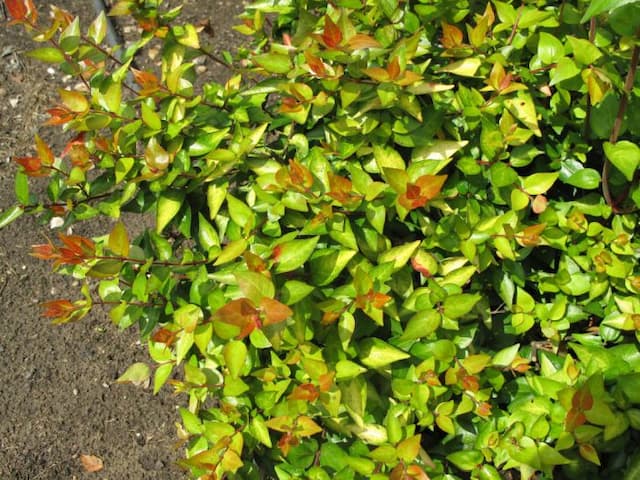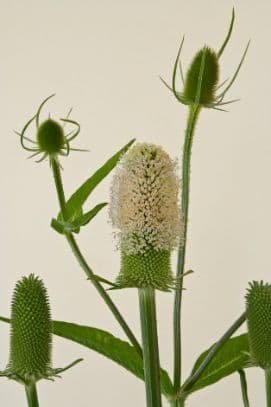Snowberry Symphoricarpos × doorenbosii 'White Hedge'

ABOUT
The White Hedge, a picturesque shrub known for its charming and ornamental qualities, brings a touch of wintry elegance to any landscape. This plant showcases an abundance of small pinkish-white flowers, which emerge in delightful clusters. The blooms burst forth along the length of its gracefully arching branches, often attracting the gentle hum of pollinators during their bloom time. As the seasons progress, the flowers give way to cute, pearl-like white berries that pepper the shrub with spots of brightness, much to the delight of local birds which enjoy them as a food source. The foliage of the White Hedge is equally impressive, comprised of small, neatly arranged oval leaves that present a lush backdrop of greenery throughout the growing season. The leaves may also undergo a transformation with the advent of autumn, often adopting hues of yellow to add a subtle but appreciable change in the visual palette of the plant. With its combination of floral beauty, ornamental berries, and vibrant leaves, the White Hedge truly serves as a year-round centerpiece in gardens and landscapes where aesthetic appeal is cherished.
About this plant
 Names
NamesFamily
Caprifoliaceae
Synonyms
Snowberry, Doorenbos Snowberry, White Hedge, Magic Berry, Waxberry, Ghostberry, Coralberry
Common names
Symphoricarpos × doorenbosii 'White Hedge'.
 Toxicity
ToxicityTo humans
Snowberry (Symphoricarpos × doorenbosii 'White Hedge') is considered to have some level of toxicity to humans if ingested. The berries, and potentially other parts of the plant, contain saponins and alkaloids that can be harmful if consumed in large quantities. Symptoms of poisoning from ingesting snowberry include vomiting, dizziness, and sedation. Ingestion of the berries can lead to gastrointestinal discomfort and could potentially result in more severe symptoms if a large amount is eaten.
To pets
Snowberry (Symphoricarpos × doorenbosii 'White Hedge') is also toxic to pets if ingested. The plant contains compounds such as saponins that can cause vomiting, diarrhea, and lethargy in animals such as dogs and cats. Ingesting the snowberry may lead to gastrointestinal upset, and, in severe cases, could result in more serious health complications depending on the amount consumed and the size of the pet. Owners should prevent their pets from ingesting any part of this plant.
 Characteristics
CharacteristicsLife cycle
Perennials
Foliage type
Deciduous
Color of leaves
Green
Flower color
White
Height
3-5 feet (0.91-1.52 meters)
Spread
4-6 feet (1.22-1.83 meters)
Plant type
Shrub
Hardiness zones
3-7
Native area
North America
Benefits
 General Benefits
General Benefits- Low maintenance: The plant requires minimal care once established, making it ideal for gardeners looking for low-maintenance landscaping options.
- Drought tolerance: It has good resistance to periods of dry weather, reducing the need for frequent watering.
- Tolerance of a variety of soils: It can thrive in a range of soil types, which makes it versatile for different garden conditions.
- Cold hardiness: Its ability to withstand cold temperatures makes it suitable for gardens in cooler climates.
- Wildlife attraction: The berries produced can attract birds, providing food for wildlife during the fall and winter months.
- Ornamental appeal: With its white flowers and berries, it adds aesthetic value to the garden throughout different seasons.
- Erosion control: It can be used on slopes and banks to help control soil erosion.
 Medical Properties
Medical PropertiesThis plant is not used for medical purposes.
 Air-purifying Qualities
Air-purifying QualitiesThis plant is not specifically known for air purifying qualities.
 Other Uses
Other Uses- Snowberry, such as Symphoricarpos × doorenbosii 'White Hedge', can be used as a dye plant; its berries can provide a soft pink or purple color when used to naturally dye fabrics.
- The dense branches of Snowberry can be utilized as framework in wreath-making or other floral crafts, giving structure to decorative pieces.
- Due to its hardy and vigorous nature, Snowberry is useful for erosion control on slopes and banks, helping to stabilize the soil with its root system.
- Snowberry bushes can be planted as a noise buffer, where their thick growth can help reduce the impact of sound from roads or industrial areas.
- Cut branches of Snowberry are sometimes used in winter arrangements for their decorative, snow-like white berries that persist after the leaves have fallen.
- In areas where other plant food sources are scarce, the persistent berries of Snowberry are appreciated by wildlife during winter, offering a valuable food reserve.
- Snowberry's dense foliage provides excellent nesting opportunities for birds, offering them protection from predators while raising their young.
- Hedgerows of Snowberry can act as windbreaks, protecting more delicate garden plants from strong winds and helping to reduce the effects of wind erosion.
- The plant can be used in permaculture designs as part of a 'food forest' to provide habitat and food for beneficial insects and animals within an ecological garden setting.
- Snowberry is sometimes incorporated into living snow fences in cold climates, where their thick, bushy growth can help to accumulate and reduce drifting snow on roads and pathways.
Interesting Facts
 Feng Shui
Feng ShuiThe Snowberry is not used in Feng Shui practice.
 Zodiac Sign Compitability
Zodiac Sign CompitabilityThe Snowberry is not used in astrology practice.
 Plant Symbolism
Plant Symbolism- Innocence - The delicate small white flowers and the pure white berries of the Snowberry (Symphoricarpos × doorenbosii 'White Hedge') are often associated with purity and innocence, akin to the unblemished snow it resembles.
- Protection - Snowberries have been used historically by Native Americans in medicine, which lends to its symbolism of protection and care.
- Hope - As a plant that can thrive in tough conditions and signals the nearing of spring when its berries often persist into winter, the Snowberry symbolizes hope and the promise of renewal.
- Forgiveness - Given its pristine appearance, the Snowberry can symbolize forgiveness, suggesting a wiping clean of past grievances and a fresh start.
 Water
WaterSnowberry, commonly known as Symphoricarpos × doorenbosii 'White Hedge', should be watered deeply to ensure the root zone is thoroughly moistened. Aim to provide about 1 inch of water per week, either through rainfall or manual watering. During the growing season, particularly in hotter, drier periods, you may need to water snowberry twice a week. Ensure the soil is well-draining to prevent waterlogging as this plant does not tolerate overly wet conditions. Reduce watering in the winter when the plant is dormant, and always check the soil moisture before watering to avoid overwatering.
 Light
LightSnowberry thrives in a variety of light conditions but prefers full sun to partial shade. It is adaptable to different light scenarios but flowering and fruiting are best in areas where it can receive at least 4-6 hours of sunlight daily. Avoid deep shade as this can lead to sparse foliage and a reduction in the number of flowers and berries.
 Temperature
TemperatureSnowberry is hardy and can withstand a broad range of temperatures, often from as low as -40°F to as high as 90°F. The ideal growing temperatures for Snowberry are between 60°F and 75°F. It can survive brief periods of extreme cold or heat but prefers moderate temperatures for optimal growth and health.
 Pruning
PruningSnowberry should be pruned to maintain shape, remove any dead or diseased wood, and promote new growth that will flower. Pruning is best done in late winter or early spring before new growth begins. Depending on the size and desired shape, pruning may be light trimming of branches or a more significant cutback every few years to rejuvenate older plants.
 Cleaning
CleaningAs needed
 Soil
SoilSnowberry 'White Hedge' thrives in well-draining, loamy soil that is rich in organic matter, with an optimal pH range of 6.0 to 7.5. A blend containing one-third peat, one-third garden soil, and one-third coarse sand or perlite is ideal.
 Repotting
RepottingSnowberry 'White Hedge' does not typically require frequent repotting; it should be done only when the plant has outgrown its current container, roughly every 2 to 3 years.
 Humidity & Misting
Humidity & MistingSnowberry 'White Hedge' is adaptable to a range of humidity levels and does not require specific humidity conditions; it can thrive in average outdoor humidity.
 Suitable locations
Suitable locationsIndoor
Place Snowberry 'White Hedge' where it gets bright, indirect light.
Outdoor
Plant Snowberry 'White Hedge' in sun to partial shade.
Hardiness zone
3-7 USDA
 Life cycle
Life cycleSnowberry 'White Hedge' begins its life as a seed, which germinates in spring when soil temperatures warm up. After sprouting, the seedling establishes roots and begins to grow upright, forming a small shrub. The shrub matures over a few years, developing a woody structure with multiple stems and a rounded shape. Once mature, Snowberry 'White Hedge' flowers in the summer, producing small pink flowers that are later replaced by distinctive white berries in the fall. The plant then enters dormancy during winter, with the leaves falling off and growth ceasing during this cold period. Each year, the cycle repeats with new growth in spring, flowering in summer, berry production in fall, and dormancy in winter.
 Propogation
PropogationPropogation time
Spring-Early Summer
The most popular method of propagation for Snowberry (Symphoricarpos × doorenbosii 'White Hedge') is through semi-hardwood cuttings. This method typically occurs during the latter part of summer, from July to September. To propagate, one would cut a 4 to 6-inch (10 to 15 centimeters) length of stem that has matured slightly but is not fully hardened. The leaves on the lower half of the cutting should be removed, and the cut end can be dipped in a rooting hormone to encourage root growth. The prepared cutting is then planted in a moist potting mix, in a container that can be kept under partially shaded conditions. It is important to maintain humidity around the cuttings, which can be achieved by covering the container with a plastic bag or placing it in a propagator. Rooting may take several weeks, after which the new plants can be gradually acclimatized to outdoor conditions before planting out.








